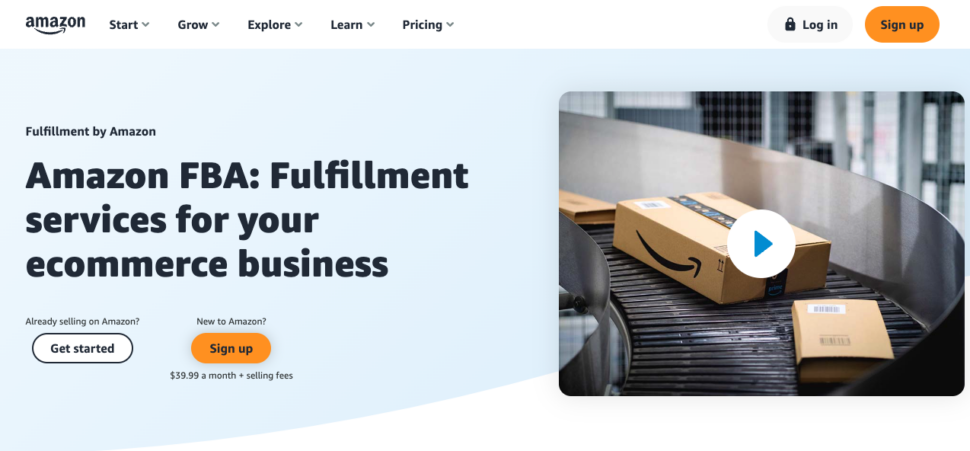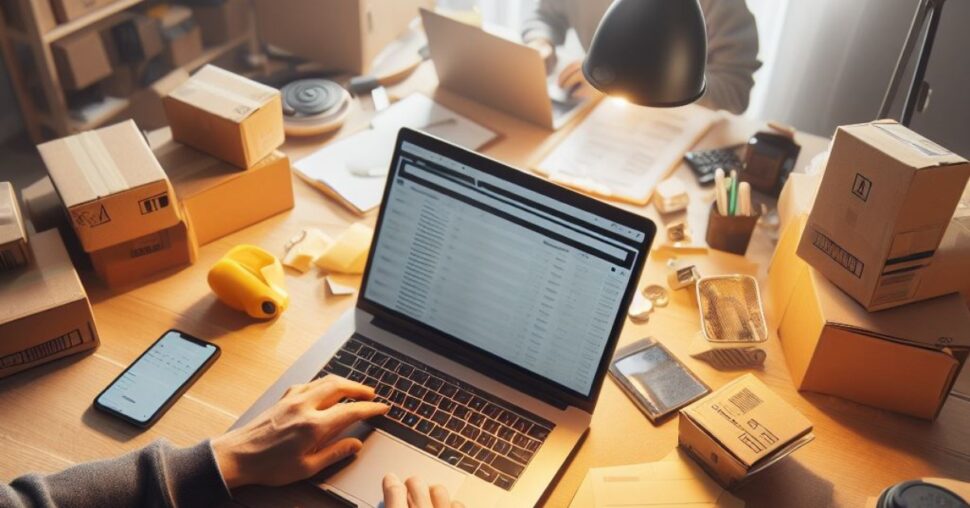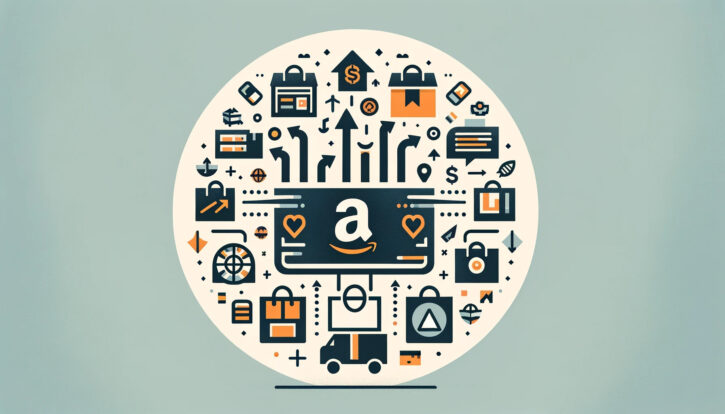How much does it cost to start selling on Amazon FBA? This comprehensive guide breaks down the startup costs of launching an Amazon FBA business – from essential fees like barcodes and subscriptions to inventory sourcing, product development, listing optimization, and marketing expenses. Whether you’re starting with a few hundred dollars or a larger investment, the article explains what you’ll need to budget and why, while also highlighting how tools like PickFu can help reduce risk and improve ROI through consumer research and split testing. Perfect for aspiring Amazon sellers asking, “Is Amazon FBA worth it – and how do I get started affordably?”
There are two ways to sell on Amazon: Fulfilled by Merchant (FBM) and Fulfilled by Amazon (FBA).
Amazon FBA vendors are overwhelmingly favored by the platform’s algorithms and make up the majority of top sellers on the site. It also means you don’t have to handle your own shipping and warehousing, which helps with overheads and reduces barriers to selling with Amazon.
That makes it enticing to become an FBA seller. If you’re reading this, you probably want to find out how to get your product into the FBA program. You’ll probably have a few other questions as well – such as whether Amazon FBA or even e-commerce in general is worth it.
To answer those questions, let’s take a look at FBA and the costs you can expect to incur as a Fulfilled by Amazon seller.
What is FBA?

FBA is Amazon’s in-house logistics solution – products sold under this program are warehoused and shipped through Amazon. You’re essentially turning over the inventory management and shipping to Amazon.
This makes it easier for Amazon to guarantee delivery times and offer Amazon Prime customers fast, free shipping. Amazon charges FBA sellers fees to cover their handling of the logistics and shipping.
All 10 of the top 10 automotive products sold on Amazon in 2024 are fulfilled by Amazon and ship directly from the Amazon warehouse within two days – even though they’re sold by other brands, including mainstream brands like Mobil and RainEx.
A search for fishing gear returns almost exclusively Amazon Prime items from FBA sellers that are shipped from Amazon’s warehouses.
A guide to FBA seller costs
Becoming an FBA seller can be lucrative, but there are costs involved. That’s because you’re passing a lot of the infrastructure, shipping, and logistics costs over to Amazon.
Individual vs professional seller accounts on Amazon
Amazon sellers can opt for an individual account or a professional account. Both of these tiers are eligible for the FBA program. The key difference in pricing is that professionals pay a $39.99/month subscription fee, while individual sellers pay a $0.99/item fee on everything they sell.
If you sell more than 40 items per month, the subscription fee is worth it regardless of anything else. Professional sellers also get access to features like:
- Special listing features like promotions and gifts
- Have products placed in Featured Offers
- Calculate taxes on goods
- Manage listings and product groups with reports and spreadsheets
- Access Amazon APIs
- Access Amazon business insights tools
- Grant access to multiple users (perfect for directors of e-commerce who want to delegate duties)
These features and the lack of the $0.99 per item fee make Amazon’s $39.99 monthly fee for professional seller accounts a compelling option.
Startup costs for FBA sellers

So how much should you budget to become an FBA seller? It all depends on what you want to achieve and how much you want to invest. You can do it for a few hundred dollars, or for several thousand.
There are a few different types of costs to consider, though.
Amazon fees
The professional seller account subscription is the first cost most FBA sellers will incur from Amazon itself.
The only other requirement is a barcode for your product. To get this you need a GTIN (Global Trade Identification Number), usually in the form of a UPC code from GS1. GS1 is the only vendor Amazon accepts for UPC codes. They cost $30.
Amazon needs this barcode to generate a Fulfillment Network Stock Keeping Unit (FKNSU) number. The company uses this number to track and manage your products.
So your total upfront costs from Amazon to become an FBA prime seller are $30 for the barcode and a $39.99 monthly subscription fee.
Total estimated costs:
Barcode from GS1: $30.00
Monthly subscription fee (first month): $39.99
Total range: $30 – $69.99
Product sourcing costs
These costs will vary widely depending on what your product is. If you opt for an existing product you believe you can make a profit on, then it’s relatively simple. Your cost is basically the purchasing price of the item you want to sell on Amazon’s marketplace.
Let’s say your product costs you $3.00 and you want to start by selling 250 of them – you’d need to invest $750 in your inventory.
You might also want to buy samples of different products, and you could spend anywhere from $50 to $500 on samples before you choose your product.
Total estimated costs:
Samples: $50 – $500
Inventory: $750 – $99,999
Total range: $750-$100,000+
Product development costs
If you’re creating your own product, then your costs will be higher. You’ll need to do product design, product validation, and also source a manufacturer for your product.
You can save on development costs by testing your product ideas on your target market. PickFu makes market research easy and affordable with surveys starting at less than $50. You can test design ideas like this rug or even gauge interest in a product like this wine glass. There are product validation and variant testing templates to make it easier for Amazon sellers at all levels to improve your performance.
Product development is a hugely variable cost, so make sure you perform in-depth market research and build out a plan before you begin.
Total estimated costs:
Design: $50 – $5,000
Market research: $50 – $99,999
Prototyping: $100 – $10,000
Manufacturing: $100 – $10,000
Total range: $500 – $10,000+
Listing design costs
There are millions of Amazon product pages and products, so it’s difficult to stand out. Here too, the possible range of costs are huge. At the very least, you need a decent product photo – expect to pay between $50 and $500 for a set of those using a professional photographer.
You also might need a graphic designer to make sure your product images and A+ content graphics pop. And of course, you’ll need to optimize your listing for your target search keywords and ensure your product page is answering shoppers’ questions.
PickFu is also helpful for multiple aspects of Amazon listing optimization.
You can use Amazon search result page (SERP) click tests to see which of your designs are more effective and compare yourself to competitors.
Take advantage of our Amazon mockup generator to design listing mockups for your and your competitors’ products. You can then use these faux listings in polls to gather customer insights through Amazon split testing, without going live to market.
You can even use PickFu to test your Amazon headlines, find out which product images are most effective, and a wide variety of other consumer research tests.
Amazon SERP optimization is important for success as an Amazon FBA seller. You can save on costs and launch more effective product listings right from the outset by using PickFu to test and optimize your listings.
Total estimated costs:
Product photography: $50 – $500
Graphic design: $100-$2,500
Market research: $50 – $1,000+
Total range: $200 – $5,000+
Marketing costs
To help your listing get traction early, you’ll need to spend some money on marketing your product. There are a few ways to do this, but the fastest and easiest way most FBA businesses attract attention is with paid search placement on Amazon.
Pay-per-click (PPC) campaigns start at just a few dollars. Amazon PPC is usually the first choice for new sellers because it’s affordable and effective.
You might also consider social media like Facebook to increase traffic to Amazon listings. Or for a bit more investment, you can try selling on TikTok using influencers and video posts.
Researching your target audience using surveys will help you maximize your advertising efforts.
Total estimated costs:
Amazon paid search placement: $10 – $1,000
Other paid advertising: $10 – $1,000+
Total range: $10 – $1,000+
Other costs
Other costs include things like business registration and getting a registered trademark. Neither of these are required, but they can help you in the long run. A registered trademark also allows you to list in the Amazon Brand Registry, which can help protect your intellectual property.
Total range: $0 – $1,000+
Ongoing costs for FBA sellers
While all these costs are startup costs, FBA sellers will also have to pay ongoing fees to Amazon. The main ones include the following:
Referral fees
These are the fees Amazon charges per item sold. It’s a fee for advertising your product on their site. Usually, it’s 15% or $0.30 per item sold but that varies by product type.
FBA fulfillment fees
Amazon fulfillment fees are the price for shipping and handling your items. Small items start at around $3.00 per item sold and the cost can climb from there for larger items. Amazon claims that FBA shipping costs are 30% less than standard shipping and up to 70% less than premium express shipping comparable to Amazon’s service.
Storage fees
You’ll also be charged storage fees for items in the Amazon warehouse. This varies by size and volume but can be anything from $3.00 per item and up.
Aged inventory fees
If your inventory sits too long Amazon will charge a long-term storage surcharge. This usually kicks in if your inventory has been sitting longer than 180 days (five months) and it adds $0.50 per cubic foot.
Low-level inventory fees
You’ll also be dinged for having too little stock in Amazon’s pipeline. This is because it prevents Amazon from distributing your product to different fulfillment centers, which costs them more money in shipping to the final user. You need to maintain more than 30 days of historical supply to avoid this fee.
Alternatives to Amazon FBA

There are alternatives to Amazon. You could be an Amazon FBM seller and handle the orders and logistics yourself.
You might also sell on other marketplace sites like Walmart Marketplace, Etsy, TikTok Shop, or Temu (check out our Temu vs. Amazon guide for e-commerce sellers). The decision to sell on other marketplaces sometimes comes down to access to FBA-style shipping arrangements, which are typically better established and more reliable with Amazon.
Making Amazon FBA work for you
The answer to “Is Amazon FBA worth it?” will depend on your risk tolerance and business model.
An Amazon store can be lucrative, and there’s very little barrier to entry. You could begin to earn passive income on Amazon for as little as a few hundred dollars. Or, you could invest tens of thousands.
The trick, as always in business, is to develop a plan, conduct market research, and optimize your product for the market.
You can save costs by split testing with PickFu and set your Amazon FBA business up for success.
Sign up for PickFu to start testing your Amazon listings even before you launch your product live on the marketplace.
Amazon FBA startup cost FAQs
How much money do you need to start Amazon FBA in 2024?
Beginners can start selling through Amazon FBA for less than $100 before inventory costs. The required fees are minimal. All you need is enough profit margin to cover the cost of selling each item. You may also need to budget for warehouse costs in your first month of operation.
Can I become an Amazon FBA seller with $500?
Yes, you can start a new business selling on Amazon for less than $500. Your biggest cost will be sourcing enough inventory to fulfill customer orders. New products pop up on Amazon every day using this very model.
What is the Amazon FBA business model?
The FBA business model sees sellers place products into Amazon’s hands for a cut of their profit margin. Amazon is better placed to warehouse goods and distribute them through the army of distribution centers all over the world. This reseller model allows business owners to sell to more customers with less overhead and less upfront cost.
How can I become an Amazon FBA seller?
A simplified step by step guide to being an FBA seller looks like this:
- Conduct product research
- Select a product to sell
- Get your product listed on the site
- Submit your product to Amazon’s FBA program
There are very few barriers to becoming an FBA seller and the initial investment is small.
Is Temu like Amazon FBA?
There are big differences between Temu and Amazon FBA. If you’re an e-commerce seller wanting to know how to sell on Temu, the short answer is that you can’t, at least for the time being – unless you’re a Chinese manufacturer. However, you should still keep an eye on the marketplace and conduct Temu split testing to optimize your listings and protect your products on other platforms.



